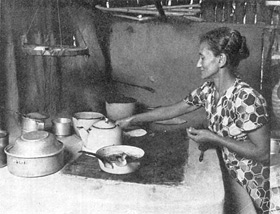 |
 |
 |
 Health & Beauty | February 2006 Health & Beauty | February 2006  
Indoor Pollution from Cooking on Wood Stoves Affects Women in Developing Countries
 American Thoracic Society American Thoracic Society


| | Biomass (wood) smoke is composed of a relatively equal mixture of coarse and ultrafine particles and can penetrate deeply into the lung, producing a variety of morphologic and biochemical changes. |
Women in developing countries who cook over a wood stove for years and inhale the smoke can develop chronic obstructive pulmonary disease (COPD) and experience the same clinical characteristics, diminished quality of life and increased mortality rates as tobacco smokers.

These findings from a Mexican study appear in the second issue for February 2006 of the American Journal of Respiratory and Critical Care Medicine, published by the American Thoracic Society.

Over a seven-year period, Alejandra Ramírez-Venegas, M.D., and six associates from the COPD Clinic at the National Institutes of Respiratory Diseases in Mexico City, followed up on clinical, functional, health-related quality of life and survival characteristics of 481 COPD patients. Of this group, 345 persons (76 percent of whom were male) had COPD associated with tobacco smoke and 186 individuals (86 percent female) developed the disease as a result of inhaling wood smoke.

Although cigarette smoking is a greater risk factor for COPD in developed countries, indoor air pollution from solid fuel use is responsible for more than 1.6 million annual deaths and 2.7 percent of the global burden of COPD in developing countries, according to the World Health Organization.

COPD results from persistent obstruction of the airways associated with either severe emphysema or chronic bronchitis. In emphysema, the tiny air sacs of the lung (alveoli) become enlarged and their walls are destroyed. In chronic bronchitis, the bronchial glands enlarge, causing a chronic cough and excess mucus. Ten to 15 percent of all smokers develop COPD as a result of irritants in tobacco that cause inflammation of the alveoli.

"Biomass (wood) smoke is composed of a relatively equal mixture of coarse and ultrafine particles and can penetrate deeply into the lung, producing a variety of morphologic and biochemical changes," said Dr. Ramírez-Venegas.

According to the authors, the patients in the wood smoke group were older, shorter and had a greater body mass than those in the tobacco smoke group.

The cumulative exposure for the wood smoke COPD patients was expressed in hour-years, the number of hours of cooking with wood stoves multiplied by the average number of hours spent daily in the kitchen. The average cumulative exposure was 214 hour-years for the wood smoke group and 56 pack years for the tobacco smokers.

"In our study, the degree of airflow limitation was worse in tobacco smokers than in subjects exposed to wood smoke," said Dr. Ramírez-Venegas. "Whether biomass exposure affects lung growth and, consequently, function in adulthood and elderly life is unclear. However, biomass smoke exposure starts early in life because women cook using wood stoves in the same room where children sleep, play and eat, increasing the risk of respiratory infections and possible reduction in lung growth. Likewise, because the girls spend more time with their mothers and help with the domestic work at a very early age, these girls as women may be more susceptible to pulmonary infection, because they may have a very long time response to biomass, lasting at least 40 to 50 years. Women stop the exposure when they leave the rural community and move to live in urban areas, such as Mexico City."

During a follow-up period of almost 7 years, 124 (26 percent) of the total patient group died. Twenty-five patients (20 percent) died as a result of biomass smoke exposure and 99 suffered from fatal COPD associated with tobacco smoke. Sixty percent of the deaths in the tobacco smoke cohort came from respiratory failure, while 48 percent of the wood smoke patients died from the same problem. | 
 | |
 |



